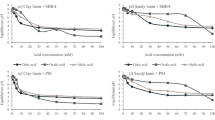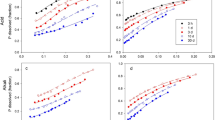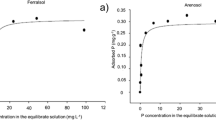Abstract
North Carolina rock phosphate (NCRP) (highly carbonate—substituted apatite) was ground to produce three samples with different particle size distributions. The effectiveness of these fertilizers was compared with the effectiveness of superphosphate in a field experiment and three glasshouse experiments using lateritic soils from south-western Australia. Non-reactive Queensland rock phosphate (low carbonate-substituted apatite from the Duchess deposit) was also used in the pot experiments. Bicarbonate-soluble phosphorus extracted from the soil is widely used in Western Australia to predict plant yields from previously-applied fertilizer dressings. For both field and pot experiments bicarbonate-extractable phosphorus (soil test value) was measured and related to subsequent plant yields.
As calculated from the initial slope of the relationship between yield and the level of P applied, finely powdered NCRP was about 5–32% as effective as freshly-applied superphosphate in the year of application and also for two years after application in the field experiment, and for two successive crops in the three pot experiments. For both field and pot experiments, finely powdered NCRP, was at best, 1.5–2.0 times as effective as granular NCRP. Relative to freshly-applied superphosphate, the effectiveness of rock phosphates usually decreased with increasing level of application.
For each of the crops in the field experiment, the relationships between yield and phosphorus content of plants (i.e. internal efficiency curves) were similar for all fertilizers. Thus the low effectiveness of the rock phosphates relative to superphosphate was solely due to much less phosphorus being taken up by plants. By contrast, in the pot experiments internal efficiency curves differed for different fertilizers. This is attributed to differences in the rate of phosphorus uptake by plant roots during the early stages of plant growth.
For both field and pot experiments, soil test calibrations (the relationship between yield and soil test value) differed for rock phosphates and superphosphate. For superphosphate, soil test calibrations also differed for the three different years after the initial application of this fertilizer in the field experiment. For the second crop in the pot experiment, soil test calibrations differed for superphosphate applied at different times (before the first and the second crop). These results point out the difficulty of applying soil testing procedures to soils that have experienced different histories of fertilizer application.
Similar content being viewed by others
References
Alston AM and Chin KW (1974) Response of subterranean clover to rock phosphates as affected by particle size and depth of mixing in the soil. Aust J Exp Agric Anim Husb 14: 649–655
AOAC (1975) ‘Official Methods of Analysis’ 12th Edn. Assoc Off Agric Chem: Washington DC
Armiger WH and Fried M (1958) Effect of particle size on availability to plants of phosphorus in phosphate rock from various sources. J Agric Fd Chem 6: 539–545
Bath JG and Cameron IH (1960) Rock phosphate for top dressing pasture. J Dept Agric Vic 58: 459–467
Black CA and Scott CO (1956) Fertilizer evaluation. I. Fundamental principles. Soil Sci Soc Am Proc 20: 176–179
Bolland MDA (1985) Residual value for wheat of phosphorus from Calciphos, Duchess rock phosphate and triple superphosphate on a lateritic soil in south-western Australia. Aust J Exp Agric 25: 198–208
Bolland MDA (1986) Residual value of phosphorus from superphosphate for wheat grown on soils of contrasting texture near Esperance, Western Australia. Aust J Exp Agric 26: 209–215
Bolland MDA (1987) Effectiveness of topdressed and incorporated superphosphates and Duchess rock phosphate for subterranean clover on sandy soils near Esperance, Western Australia. Aust J Exp Agric 27: 87–92
Bolland MDA and Barrow NJ (1988) Effect of level of application on the relative effectiveness of rock phosphate. Fert Res 15: 181–192
Bolland MDA and Bowden JW (1984) The initial and residual value for subterranean clover of phosphorus from crandallite rock phosphates, apatite rock phosphates and superphosphate. Fert Res 5, 295–307
Bolland MDA and Bowden JW (1986) Summary of longterm rock phosphate experiments in south-western Australia. J Aust Instit Agric Sci 52, 227–236
Bolland MDA and Gilkes RJ (1987) How effective are Calciphos and Phospal? Fert Res 12: 229–239
Bolland MDA, Gilkes RJ and Allen DG (1988) The residual value of superphosphate and rock phosphates for lateritic soils and its evaluation using three soil phosphate tests. Fert Res 15, 253–280
Bolland MDA, Gilkes RJ and D'Antuono MF (1988) The effectiveness of rock phosphate fertilizers in Australia: a review. Aust J Exp Agric 28: 655–668
Bolland MDA, Weatherley AJ, Gilkes RJ and Bowden JW (1986) Granular reactive apatite rock phosphate is not an effective phosphorus fertilizer in the short term on lateritic soils in south-western Australia. Aust J Exp Agric 26: 217–225
Bolland MDA, Weatherley AJ and Gilkes RJ (1988) Residual effectiveness of superphosphate is greater than that of rock phosphate fertilizers for lateritic soils in southwestern Australia. Aust J Exp Agric 28: 83–90
Bowden JW and Bennett D (1976) The ‘Decide’ model for predicting superphosphate requirements. Proc Phos Agric Symp 1975 (Aust Instit Agric Sci: Parkville, Vic)
Chien SH, Adams F, Khasawneh FE and Henao J (1987) Effects of combinations of triple superphosphate and a reactive phosphate rock on yield and phosphorus uptake of corn. Soil Sci Soc Am J 51: 1656–1658
Chien SH and Hammond LL (1978) A comparison of various laboratory methods for predicting the agronomic potential of phosphate rocks for direct application. Soil Sci Soc Am J 42: 935–939
Colwell JD (1963) The estimation of phosphorus fertilizer requirements of wheat in southern New South Wales by soil analysis. Aust J Exp Agric Anim Husb 3: 190–197
Colwell JD (1985) Fertilizer programs. I. Variability in responses of successive crops to fresh and previous applications of phosphorus fertilizer, in Australia and Brazil. Fert Res 8: 21–38
Cooke GW and Widdowson FV (1959) Field experiments on phosphate fertilizers: A joint investigation. J Agric Sci 53: 46–63
Engelstad OP, Jugsujinda A and De Datta SK (1974) Response by flooded rice to phosphate rocks varying in citrate solubility. Soil Sci Soc Am Proc 38: 524–529
Fenster WE and Leon LA (1978) Utilization of phosphate rock in tropical soils in Latin America. Seminar on Phosphate Rock for Direct Application, Haifa, Israel. pp 172–210 (Special public IFDC-81, Muscle Shoals: Alabama)
Ghosh AK and Gilkes RJ (1987) The initial and residual effectiveness of some Indian, USA and Australian rock phosphates. Fert Res 12: 201–218
Hammond LL (1978) Agronomic measurement of phosphate rock effectiveness. Seminar on Phosphate Rock for Direct Application, Haifa, Israel. pp 147–173. (Special Public IFDC-81, Muscle Shoals: Alabama)
Hammond LL, Chien SH and Easterwood GW (1986) Agronomic effectiveness of Bayover phosphate rock in soil with induced phosphorus retention. Soil Sci Soc Am J 50: 1601–1606
Hughes JC and Gilkes RJ (1986) The effect of rock phosphate properties on the extent of fertilizer dissolution in soils. Aust J Soil Res 24: 209–217
Hughes JC and Gilkes RJ (1986) The effect of soil properties and level of fertilizer application on the dissolution of Sechura rock phosphate in some soils from Brazil, Columbia, Australia and Nigeria. Aust J Soil Res 24: 219–227
Jackson EA (1966) Phosphorus fertilizer research in Australia. CSIRO Bulletin No 284
Jones E (1975) Comparisons of different forms of phosphatic fertilizers. I. Rape and swedes. J Soil Sci 26: 66–73
Kanabo IAK and Gilkes RJ (1987) A comparison between plant response and chemical measurement of the dissolution of reactive phosphate rock in soils of different pH and phosphorus retention. Aust J Soil Res 25: 451–460
Kanabo IAK and Gilkes RJ (1988) The effects of moisture regime and incubation periods on the dissolution of North Carolina phosphate rock in soil. Aust J Soil Res 26: 153–163
Kanabo IAK and Gilkes RJ (1988) The effect of the level of phosphate rock application on its dissolution in soil and on bicarbonate-soluble phosphorous. Fert Res 16: 67–85
Khasawneh FE and Doll EC (1978) The use of phosphate rock for direct application to soils. Ad Agron 30: 159–206
Leon LA, Fenster WE and Hammond LL (1986) Agronomic potential of eleven phosphate rocks from Brazil, Columbia, Peru and Venezuela. Soil Sci Soc Am J 50: 798–802
Mackay AD, Syers JK and Gregg PEH (1984) A glasshouse comparison of 6 phosphate fertilizers. NZ J Exp Agric 12: 131–140
Murphy J and Riley JP (1962) A modified single solution method for the determination of phosphate in natural waters. Anal Chim Acta 27: 31–36
Northcote KH (1979) A factual key for recognition of Australian Soils. 4th Edn. (Rellim Techn Publ: Glenside, South Australia)
Ozanne PG and Shaw TC (1967) Phosphate sorption by soils as a measure of the phosphate requirement of pasture growth. Aust J Agric Res 18: 601–612
Palmer B and Gilkes RJ (1982) Agronomic evaluation of calcined Christmas Island iron-aluminium phosphate fertilizers. Proc Phos Pot Tropic Conf, Kuala Kumpur (Eds E Puspharajah and HAH Sharifuddin). pp 495–507. (Malay Soc Soil Sci: Malaysia)
Palmer B, Bolland MDA and Gilkes RJ (1979) A reevaluation of the effectiveness of calcined Christmas Island C-grade rock phosphate. Aust J Exp Agric Anim Husb 19: 605–610
Ross GJS (1980) ‘MLP Maximum Likelihood Program’ (Rothamsted Exp Stat: Harpenden, UK)
Walkley A and Black IA (1934) An examination of the Degtjareff method of determining soil organic matter and a modification of the chromic and titration method. Soil Sci 37: 29–38
Weatherley AJ, Bolland MDA and Gilkes RJ (1988) A comparison of values for initial and residual effectiveness of rock phosphates measured in pot and field experiments. Aust J Exp Agric 28: 753–763
Author information
Authors and Affiliations
Rights and permissions
About this article
Cite this article
Bolland, M.D.A., Gilkes, R.J. Reactive rock phosphate fertilizers and soil testing for phosphorus: The effect of particle size of the rock phosphate. Fertilizer Research 21, 75–93 (1989). https://doi.org/10.1007/BF01080533
Received:
Accepted:
Issue Date:
DOI: https://doi.org/10.1007/BF01080533




